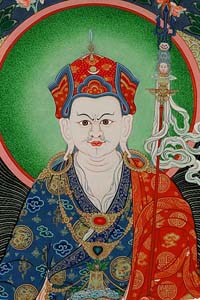
Text
Meanings
1) The Common
Hidden meaning according to:
2) The path of liberation
3) The perfection stage
4) Nyingthig of Dzogpa Chenpo
5) The accomplishment of the result
 |
|
Introduction to this web edition The following small web is devoted to The Vajra Seven-Line Prayer (tib. rdo-rje tshig-bdun) and is a rearrangement of the text as found at Quiet Mountain. It is excerpted from the excellent book Enlightened journey by Tulku Thondup, © 1995. Published by Buddhayana. First edition, 1979; second edition, 1989. My small changes and additions compared to the text at Quiet Mountain (and thus from the published book) are as follows: I) The root text is given in 1) Tibetan 2) transliterated Latin (Wylie transliteration) and 3) in phonetic transcription. II) All Tibetan terms in the translation commentary have been changed to transliterated Latin instead of phonetic transcription. III) I’ve added a small vocabulary of the Tibetan terms used in the prayer. IV) I’ve added a few Sanskrit equivalents. - Lennart Warnemyr
Tulku Thondup’s introduction This chapter [of Enlightened journey] is a summary of a commentary on The Vajra Seven-Line Prayer, entitled padma karpo (The White Lotus), written by Mipham Namgyal (1846-1912), a celebrated scholar of the Nyingma Buddhist tradition of Tibet. The original Tibetan text of Mipham’s commentary is very profound and difficult to understand or to translate, and I have summarized the basic points of his text in this chapter. The Vajra Seven-Line Prayer is the most sacred and important prayer in the Nyingma tradition. This short prayer contains the outer, inner, and innermost teachings of the esoteric trainings of Buddhism. By practicing The Vajra Seven-Line Prayer according to any one of these trainings, the result of that particular training will be attained. In this summary there are five levels of interpretation. They are
(1) the general or common meaning;
the path of the hidden meaning (sbas don), consisting of the next three levels:
(2) the meaning according to the path of liberation (grol lam); (3) the meaning according to the perfection stage (rdzog rim); (4) meaning according to the Nyingthig of Dzogpa Chenpo: the direct realization of the spontaneous (lhun grub thod rgal); and
(5) the meaning according to the accomplishment of the result.
From among these levels of meaning it is proper for a person reciting the vajra prayer to learn and practice the particular level that is suitable to his or her capacity. I have arranged this summary merely with the hope of being able to indicate that this brief prayer contains different levels of meaning and training, as many followers of the Nyingma teachings who are acquainted with The Vajra Seven-Line Prayer are often unaware of its deeper meanings, But in order to comprehend the complete meaning of the prayer, I urge the readers to read the original text of Mipham Rinpoche. In Tibet, the Nyingmas recite The Vajra Seven-Line Prayer to Guru Rinpoche three times before reciting any other prayers, doing any meditation, or performing any ceremony. Many devotees repeat it hundreds of thousands of times, reciting it during all their waking hours, making it as their main prayer, breathing, life, and contemplation. |